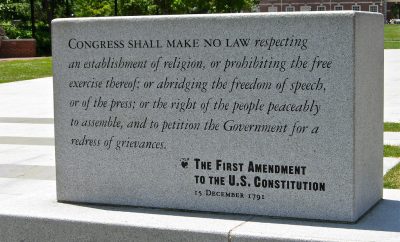 Image courtesy of [Paige via Flickr]
Image courtesy of [Paige via Flickr]
Law
Capital Punishment: Is American Opinion Changing?
Capital punishment has long been a controversial practice in the United States. Some feel that society needs to rid the country of America’s most heinous criminals in order to make room for new prisoners or to save taxpayer money, while others point out that the U.S. has executed more than 150 innocent people and this punishment cannot be undone. But why do people feel so strongly about the death penalty, how have their feelings changed over time, and what does this mean for capital punishment moving forward?
The Death Penalty Today
Demographics of the Death Penalty
In 2013, of the 2,979 inmates on death row, roughly half of them were held in four states: California, Texas, Florida, and Pennsylvania. Divided by race, inmates were 56 percent white and 42 percent black. Along gender lines, men outnumbered women one to 49, with men comprising 98 percent of death-row inmates and women only two percent.
Which states still use the death penalty?
The following states still use capital punishment:
| Alabama Arizona Arkansas California Colorado Delaware Florida Georgia Idaho Indiana Kansas |
Kentucky Louisiana Mississippi Missouri Montana Nevada New Hampshire North Carolina Ohio Oklahoma |
Oregon Pennsylvania South Carolina South Dakota Tennessee Texas Utah Virginia Washington Wyoming |
The federal government and military also use capital punishment.
Each state determines which crimes are punishable by death. Crimes other than murder that can end in a death row sentence include rape of a child, weapons of mass destruction resulting in death, aggravated kidnapping, assault by an escaped capital felon, and aircraft hijacking.
The U.S. Federal Government uses the death penalty for 41 capital offenses including murder for hire, treason, terrorism, espionage, genocide, large-scale drug trafficking, and attempting to kill a witness, juror, or court officer in certain cases.
The following states abolished or no longer use capital punishment:
| Alaska (1957) Connecticut (2012) Hawaii (1957) Illinois (2011) Iowa (1965) Maine (1887) Maryland (2013)) |
Massachusetts (1984) Michigan (1846) Minnesota (1911) Nebraska (2015) New Jersey (2007) New Mexico (2009) New York (2007) |
North Dakota (1973) Rhode Island (1984) Vermont (1964) Washington, D.C. (1981) West Virginia (1965) Wisconsin (1853) |
When the death penalty was removed or abolished in some states, lawmakers were faced with the question of what to do with those already on death row. Should those sentenced to death before the new law be allowed to live? In New Mexico and Connecticut, the answer was no. In 2009 when New Mexico eliminated the penalty, the law was not retroactive, which meant the two people on the state’s death row would still face execution. As of 2015, those two are still on death row. Also those who committed crimes worthy of the death penalty before 2009 could still face execution. The same ruling occurred in Connecticut, which had 11 people still on the state’s death row.
Arguments For and Against the Death Penalty
According to a 2014 Gallup poll, the most common justification for the death penalty is that the punishment fits the crime: an eye for an eye. This reasoning has dramatically decreased in the last 13 years, with 48 percent support in 2001, to 35 percent in 2014. Other reasons include a belief that the convicted person deserves it, that the death penalty can be used to set an example, and that it saves taxpayer money.
According to the same poll, the most popular reasons why people do not support capital punishment include a belief that it’s wrong to take a life at (40 percent), the fear of wrongful execution (17 percent), and religious purposes (17 percent). The fact that it costs more to keep prisoners on death row is very far down the list, polling at only two percent.
These are the various ways in which Americans perceive the death penalty, but are they correct?
The Cost of the Death Penalty
Despite 14 percent of Americans supporting the death penalty in order to save taxpayer dollars, it is actually more expensive to kill an inmate than to incarcerate him for the rest of his life. This revelation complicates the argument over whether or not it makes sense to employ the punishment.
A Los Angeles Times study found that the state of California spent more than $250 million per execution. California has executed 11 people over the course of 27 years and spends an average of $114 million per year on death row inmates. The state spends an additional $114 million per year on security and legal representation. The study also found that housing a death row inmate costs $90,000 more than non-death row inmates. Since reinstating the death penalty in 1978, California has spent more than $4 billion on executions. The reason why death row inmates are so costly is due to the complex and drawn out judicial process. Appeals cost the state and federal government time and money, and the concrete evidence needed, such as DNA testing, is costly.
Other states have also found that the cost of the death penalty is higher than life sentence cases as well. A Seattle University study that examined death penalty cases in Washington state since 1997 concluded that on average capital punishment cases cost $1 million more than cases that did not seek the death penalty, with costs of $3.07 million and $2.01 million, respectively. Defense and prosecution costs were more than triple in death penalty cases. Since Washington reinstated the death penalty in 1981, the state has spent $120 million on five executions with an average of $24 million per execution.
In Nevada the cost of a capital punishment case is between $1.03 million and $1.3 million while a non-capital punishment case costs about $775,000. The reason for this difference is because death penalty cases are more lengthy and costly to make certain that the sentence is correct.
The average time a convict sits on death row has been increasing since the 1980s. In 1984 the average time between sentencing and execution was 74 months, or a little over six years. In 2012 it was 190 months, or nearly 16 years. That means the average inmate executed in 2015 was convicted in 1999.
In order to prove a fair sentence for execution all doubts must be erased. That is why death row inmates are given due process and appeals after their original sentences.
Concerns Over Wrongful Executions
Even today death row inmates are exonerated due to new evidence and doubts. As of May 2015 there have been 152 people exonerated from death row in United States history, leading to the concern that the justice system is far from infallible.
For example, in 2015 accused murderer Anthony Ray Hilton was freed after 30 years on death row in Alabama. His case made it to the Supreme Court and his defense attorney during his 1985 trial was found “constitutionally deficient” and ballistic evidence proved that he was not the murderer. The case was dropped by the Jefferson County district attorney’s office on April 1, 2015 and two days later his conviction was overturned. Because of his wrongful incarceration, Hilton missed the birth of his grandchild and the death of his mother.
So, is public opinion on the death penalty changing?
Since the 1930s, statistics show that a majority of the U.S. population supports the death penalty. The public’s opinion has fluctuated slowly over time with approval increasing from 47 percent in 1967 to 80 percent in 1995 and decreasing to 63 percent in 2014.
One thing is clear: Americans are losing confidence in the death penalty. According to Gallup, since the late 1990s, support for the death penalty for a convicted killer has fall by 17 percent and opposition has increased by 17 percent.
Conclusion
Capital punishment is legally complicated in many states. Some have the death penalty but do not use it. Others have abolished it but can still sentence people to death. Americans have a lot of things to take into account when deciding what side of the debate they fall into–whether its ethics, costs, or the time it takes to enact capital punishment. The more than 150 confirmed wrongful executions in the United States show that trials and law are not infallible. While approval of the death penalty continues to decrease every year, it’s doubtful that the U.S. will be making a big change any time soon.
Resources
Primary
Bureau of Justice Statistics: Prisoners in 2013
U.S. Department of Justice: Capital Punishment
Additional
Death Penalty: The High Cost of the Death Penalty
Death Penalty: Cost of the Death Penalty
Guardian: Alabama Man Off Death Row After 28 Years
Death Penalty Info: States With and Without the Death Penalty








Comments